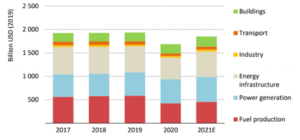In news
The International Energy Agency (IEA) released the World Energy Investment Report, 2021 recently.
About IEA’s report
The report examines how investors are assessing risks and opportunities across all areas of fuel and electricity supply, efficiency and research and development, against a backdrop of a recovery in global energy demand as well as strengthened pledges from governments and the private sector to address climate change.
The report focuses on two key questions: whether the growing momentum among governments and investors to accelerate clean energy transitions is translating into an actual uptick in capital expenditures on clean energy projects; and whether the energy investment response to the economic crisis caused by the Covid-19 pandemic will be broad-based or if some sectors, geographies and vulnerable parts of the world’s population will be left behind.
Key highlights of the report
Investment level in energy sector:
- According to IEA’s estimation, Global energy investment is expected to rebound in current year and increase 10 percent year-on-year to around $1.9 trillion
- The report states that most of this investment will flow towards power and end-use sectors, shifting out of traditional fossil fuel production

Renewable energy
- Renewable power will have the largest share around 70 percent of the total $530 million will be spent on new power generation capacity.
- As per the report, substantial gain of renewable energy as the future energy outlook has been dependent on technological development, well-established supply chain and demand from consumers for carbon-neutral electricity.
- Energy efficiency sector will also see a substantial rise (10 per cent) in investment, though the low fossil fuel price may act as a deterrent.
- The scenario is perfectly aligned with the projection that global energy demand will rise 4.6 per cent year-on-year in 2021, offsetting its contraction in 2020.
Carbon dioxide emission
- But the above positive scenarios will still not deter the increase in carbon dioxide emission, after contraction in 2020 mainly due to economic slowdown induced by the COVID-19 pandemic.
- The IEA projected that Global emission is set to grow by 1.5 billion tonnes this year.
- Upstream investment in oil is expected to grow 10 per cent.
- This expansion in fossil fuels was planned with novel technologies like carbon capture and storage (CCS) and bioenergy CCS, which are yet to attain commercial success.
- The increment of coal-fired power in 2020, mostly driven by China, is indicating that ‘coal is down but not yet out’.
Why is there an increase in the emission?
- The pandemic recovery strategies in many countries lack the required stimulant towards emission biennial technologies and pathways. The rhetoric around ‘Net Zero’ is gaining momentum but its transition to actual action is not visible.
- The emerging market is almost 70 per cent responsible for demand growth and India plays an important part in this block.
- China is showing a tremendous expansion in coal-based power production. Their coal consumption in December 2020 was a historic high though the country has a commendable renewable growth.
- The responsibility-share of developed nations should not be undermined:
- Their in-country growth of emission is moderate but their exported emission is of concern.
- Australia’s exported emission through coal is double its domestic emission
- The new President of the United States has shown renewed commitment to the multilateral United Nations system for tackling climate change by re-joining the Paris agreement. But the country’s fascination with cheap shell gas is creating an investment distortion and adversely affecting the sustainability of developmental pathways of countries like India.
Suggestions of the report
- Market stimulus amid the pandemic may have lost the opportunity to maximise the clean developmental pathway, which the world is in dire need of.
- The urgency visible in communication is still not satisfactorily reflected in action and the world is far away from the scientific target of limiting climate change within two degrees Celsius.
- A more democratic decision-making process and de-corporatisation of the energy sector is the need of the future for the survival of the civilisation on this planet.
Net zero Emission
Net zero refers to the balance between the amount of greenhouse gas produced and the amount removed from the atmosphere. We reach net zero when the amount we add is no more than the amount taken away.
Extra reading : https://journalsofindia.com/international-energy-agency-iea/
















